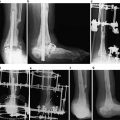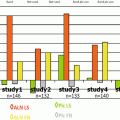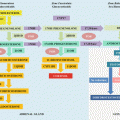Causes of primary adrenal insufficiency
• Acute or insidious presentation
– Autoimmune adrenal insufficiency or Addison’s disease (70 % in developed countries)
– Autoimmune polyglandular syndrome
– Metastatic deposits from lung, breast, kidney, etc.
– Lymphoma
– Tuberculosis (common developing countries)
– Histoplasmosis, cryptococcosis
– HIV (up to 5 % patients with AIDS)
– Infarction (anti-phospholipid syndrome)
– Adrenoleukodystrophy (inherited disorder of long chain fatty acid metabolism, presents in childhood, may progress to severe neurological problems and possibly dementia)
– Congenital adrenal hyperplasia
– Congenital adrenal hypoplasia (mutation/deletion of DAX 1/SF 1 genes)
– Familial glucocorticoid deficiency (various mutations, mineralocorticoids usually spared)
– Adrenalectomy
– Drugs (ketoconazole, fluconazole, phenytoin, rifampicin, etomidate, aminoglutethimide)
– Haemorrhage (trauma, anticoagulants)
– Waterhouse–Friderichsen syndrome (meningococcal septicaemia)
Causes of secondary and tertiary adrenal insufficiency
• Withdrawal of exogenous glucocorticoid, very common (suppression of the hypothalamo-pituitary-adrenal axis, abrupt withdrawal can cause adrenal crisis)
• Pituitary tumours
• Pituitary apoplexy (acute presentation)
• Pituitary surgery
• Pituitary radiotherapy
• Treated Cushing’s disease
• Tuberculosis, sarcoidosis, langerhans cell histocytosis, haemochromatosis, lymphocytic hypophysitis
• Isolated ACTH deficiency (rare)
• Trauma to the pituitary
Diagnostic Tests (Tables 10.2 and 10.3)
Table 10.2
Investigations to confirm adrenal insufficiency
Tests | Procedure | Interpretation of the result | Comments |
|---|---|---|---|
Short Synacthen test (SST) | Take blood sample for 9 a.m. cortisol and 9 a.m. ACTH level Administer 250 mcg Synacthen/Tetracosactrin (ACTH) i.m. or i.v. 30 min later collect blood sample for serum cortisol level | Serum cortisol response <450 nmol/L at 30 min confirms adrenal insufficiency | Different criteria may apply according to cortisol assay Recent onset secondary adrenal failure may produce a normal response SST can be done at any time of the day Oestrogens can give falsely high cortisol levels by elevating cortisol- binding globulin; discontinue oestrogen at least for 6 weeks prior to the SST If already on glucocorticoid replacement, omit steroid dose before the test, except dexamethasone For hydrocortisone or prednisolone hold off evening and morning dose |
Insulin tolerance test | Overnight fast state, insert cannula, take venous blood for basal glucose and cortisol, administer iv soluble insulin 0.15 units/kg, collect venous blood at 30, 45,60,90, and 120 min for glucose and cortisol Repeat insulin dose if glucose does not fall <2.2 mmol/L at 45 min | Fall of glucose <2.2 mmol/L with corresponding failure of cortisol response >450 nmol/L confirms adrenal insufficiency (but depends on cortisol assay) | Contraindications • Basal cortisol <100 nmol/L • Untreated hypothyroidism • Abnormal ECG • Ischaemic heart disease • Seizure history • Craniotomy • Age >70 “Gold standard test” Sensitive test for recent onset secondary adrenal insufficiency Discontinue oestrogen at least for 6 weeks prior to the test |
9 a.m. cortisol level | Collect serum cortisol level at 9 a.m. | 9 a.m. cortisol <100 nmol/L suggests adrenal insufficiency | Can be useful in recent onset secondary adrenal insufficiency (2 weeks) In severe stress such as sepsis a “normal” level may still indicate adrenal insufficiency |
Random cortisol | Collect random serum cortisol level if adrenal insufficiency is suspected, prior to steroid replacement | Undetectable level suggests adrenal insufficiency | Not very reliable, unless very low |
Table 10.3
Investigations to differentiate primary from secondary adrenal insufficiency
Tests | Procedure | Interpretation of the results | Comments |
|---|---|---|---|
9 a.m. serum ACTH level | Take venous blood sample at 9 a.m. | Elevated ACTH (>60 ng/L) confirms primary adrenal insufficiency Low ACTH level (<10 ng/L) confirms secondary or tertiary adrenal insufficiency | ACTH 10–20 ng/L can be equivocal, consider long Synacthen test |
Long Synacthen test | Take blood sample for 9 a.m. cortisol and ACTH level Administer 1 mg depot Synacthen i.m. Collect blood sample for serum contisol level at 30, 60, 120 min, 4, 8, 12 and 24 h | Progressive rise in cortisol response in secondary adrenal insufficiency Little or no response in primary adrenal insufficiency | Useful in differentiating primary from secondary adrenal insufficiency when ACTH level is equivocal |
In the first instance, adrenal insufficiency needs to be confirmed with dynamic tests unless there is an Addisonian crisis. The next step is differentiation of primary from secondary adrenal insufficiency by measuring the level of ACTH. Once the primary or secondary diagnosis has been established, further investigations, e.g. imaging, auto-antibodies or microbiological screening, should be arranged to identify the underlying cause of the adrenal insufficiency. There is no need to wait for the biochemical confirmation in an adrenal crisis; treatment should be initiated without any delay as soon as suspected clinically but a blood sample taken at this time for cortisol and if possible ACTH is extremely helpful [7].
Investigations to Establish the Underlying Cause of Adrenal Insufficiency
Adrenal autoantibodies (21-hydroxylase autoantibody present in 80 %, side-chain-cleavage enzyme and 17-hydroxylase)—autoimmune primary adrenal insufficiency
Stay updated, free articles. Join our Telegram channel

Full access? Get Clinical Tree






